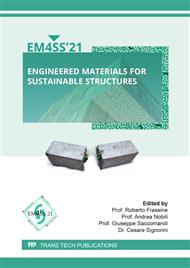[1]
United Nations, Sustainable Development Goals, 2021. Available at: https://sdgs.un.org/goals (Accessed on June 2021).
Google Scholar
[2]
UNEP – United Nations Environment Programme, 2020 Global status report for buildings and construction: towards a zero-emission, efficient and resilient buildings and construction sector. Nairobi, (2020).
Google Scholar
[3]
ISO – International Standard Organisation, ISO 14040:2006 – Environmental management – Life Cycle Assessment – Principles and framework. International Standard Organisation, Switzerland, (2006).
DOI: 10.1065/lca2005.03.001
Google Scholar
[4]
A. Paiano, T. Gallucci, A. Pontrandolfo, G. Lagioia, P. Piccinno, A. Lacalamita, Sustainable options for paints through a life cycle assessment method, Journal of Cleaner Production 295 (2020) 126464.
DOI: 10.1016/j.jclepro.2021.126464
Google Scholar
[5]
E. Shittu, V. Stojceska, P. Gratton, M. Kolokotroni, Environmental impact of cool roof paint: case-study of house retrofit in two hot islands, Energy & Buildings 217 (2020) 110007.
DOI: 10.1016/j.enbuild.2020.110007
Google Scholar
[6]
I. Merta, A. Mladenovič, J. Turk, A. Šajna, A. Mauko Pranjić, Life cycle assessment of natural fibre reinforced cementitious composites, Key Engineering Materials 761 (2018) 204–209.
DOI: 10.4028/www.scientific.net/kem.761.204
Google Scholar
[7]
S.P. Wang, W.J. Chen, Z.H. Wang, X.Z. Gong, C.Z. Zhao, L.P. Ma, life cycle assessment of PVC-U plastic window production, Key Engineering Materials 599 (2014) 319–323.
DOI: 10.4028/www.scientific.net/kem.599.319
Google Scholar
[8]
C.W. Scheuer, G.A. Keoleian, P. Reppe, Life cycle energy and environmental performance of a new university building: modeling challenges and design implications. Energy and Buildings 35 (2003) 1049-1064.
DOI: 10.1016/s0378-7788(03)00066-5
Google Scholar
[9]
Hischier, R., Nowack, B., Gottschalk, F. et al. Life cycle assessment of façade coating systems containing manufactured nanomaterials. J Nanopart Res 17, 68 (2015).
DOI: 10.1007/s11051-015-2881-0
Google Scholar
[10]
Bonoli, A., Franzoni, E. Life Cycle Assessment (LCA) analysis of renders and paints for the restoration of historical buildings. IOP Conf Ser: Earth Environ Sci, 296, 012022 (2019).
DOI: 10.1088/1755-1315/296/1/012022
Google Scholar
[11]
Paiano, A., Gallucci, T., Pontrandolfo, A., Lagioia, G., Piccinno, P., Lacalamita, A., Sustainable options for paints through a life cycle assessment method. Journal of Cleaner Production, 295, 126464 (2021).
DOI: 10.1016/j.jclepro.2021.126464
Google Scholar
[12]
Van Stijn, A., Malabi Eberhardt, L.C., Wouterszoon Jansen, B., Meijer, A. A Circular Economy Life Cycle Assessment (CE-LCA) model for building components. Resources, Conservation and Recycling, 174, 105683 (2021).
DOI: 10.1016/j.resconrec.2021.105683
Google Scholar
[13]
Cerved-Databank. Pitture e vernici per l'edilizia – Produzione Italia.
Google Scholar
[14]
ISO – International Standard Organisation. ISO 14044:2006/A1:2018 – Environmental management, Life cycle assessment, Requirements and guidelines. International Standard Organisation, Switzerland, (2006).
DOI: 10.3403/30290345
Google Scholar
[15]
International EPD System, Product Category Rules (PCR) – Construction products and construction services, (2019).
Google Scholar
[16]
EPDLA – European Polymer Dispersion & Latex Association, Life cycle inventory of polymer dispersions, Personal communication, (2019).
Google Scholar
[17]
Dorfner, Life cycle analysis data for kaolin/clay products, Personal communication, (2019).
Google Scholar
[18]
G. Wernet, C. Bauer, B. Steubing, J. Reinhard, E. Moreno-Ruiz, B. Weidema, The ecoinvent database version 3 (part I): overview and methodology. The International Journal of Life Cycle Assessment 21 (2016) 1218–1230.
DOI: 10.1007/s11367-016-1087-8
Google Scholar
[19]
ANFIA – Associazione Nazionale Filiera Industria Automobilistica, Dossier trasporto merci su strada in Unione Europea e in Italia, pp.1-57, 2019. Available at: https://www.anfia.it/it/pubblicazioni-dossier (Accessed on June 2021). [in Italian].
Google Scholar
[20]
Mapei SpA, Dichiarazione ambientale di prodotto – Colorite Matt, Dursilite, Dusrsilite Matt, Dursilite Plus, Dursilite Gloss, The International EPD System, (2017).
Google Scholar
[21]
San Marco Group SpA, Dichiarazione ambientale di prodotto – Sistema Marcotherm Acrisyl, The International EPD System, (2019).
Google Scholar


